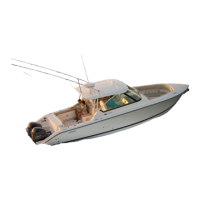Do you have a question about the PURSUIT 3070 OFFSHORE and is the answer not in the manual?
Explains DANGER, WARNING, CAUTION, NOTICE statements and provides an important note on fuel safety.
Details on the limited warranty, product changes, and how to transfer warranty coverage.
Key responsibilities including boat registration, insurance, accident reporting, and safety education.
Information on essential safety equipment mandated by the U.S. Coast Guard and local authorities.
Operation of neutral safety switches and engine power tilt/trim features.
Overview of the fuel system, including fuel fills, vents, and withdrawal tubes.
Step-by-step safe fueling procedures and precautions against static electricity.
Overview of AC/DC systems, batteries, and the 12-volt system operation.
Operation of battery switches and the automatic battery system for charging.
Introduction to the AC system and recommended procedure for connecting to shore power.
Safety precautions for connecting to shore power, including polarity checks and hazards.
Steps for filling the fresh water tank, purging air, and operating the pump.
Introduction to raw water systems, pump connections, and priming procedures.
CO hazards, bilge ventilation, and maintenance of ventilation components.
Using the toilet, waste transfer to the holding tank, and vacuum system.
Importance of safety equipment and the function of engine alarms.
Operation of safety switches and a list of essential required safety equipment.
Requirements for PFDs and types of visual distress signals.
Details on non-pyrotechnic signals, navigation lights, and fire extinguisher requirements.
Specific fire extinguisher info and dangers of carbon monoxide exposure.
Operation of the CO detector and symptoms of carbon monoxide poisoning.
CO detector reliability and preventing exhaust fume buildup via ventilation.
CO safety during engine operation and importance of first aid.
Essential steps before starting engines and general boat operation guidance.
A detailed checklist ensuring the boat is ready for safe operation.
Checks after starting engines and operator responsibilities for safe boating.
Procedures for anchoring, handling system failures, and responding to collisions.
Legal requirements and safety advice for grounding, towing, and rendering assistance.
Actions for flooding, capsizing, fishing safety, and man overboard recovery.
Steps for preparing the boat for storage, including fuel and engines.
Procedures for draining and winterizing the fresh water system, including antifreeze use.
Winterizing raw water systems, generators, and marine toilets.
Winterizing air conditioner, bilge compartments, and hard top legs.
Steps for recommissioning the boat, including checks and routine maintenance.
A table outlining recommended maintenance tasks and their frequency.
Form for reporting boating accidents, including vessel and accident data.
Troubleshooting common issues with hydraulic steering and control systems.
Troubleshooting common engine issues like overheating and charging problems.
Troubleshooting common problems with accessories like livewell and bilge pumps.
